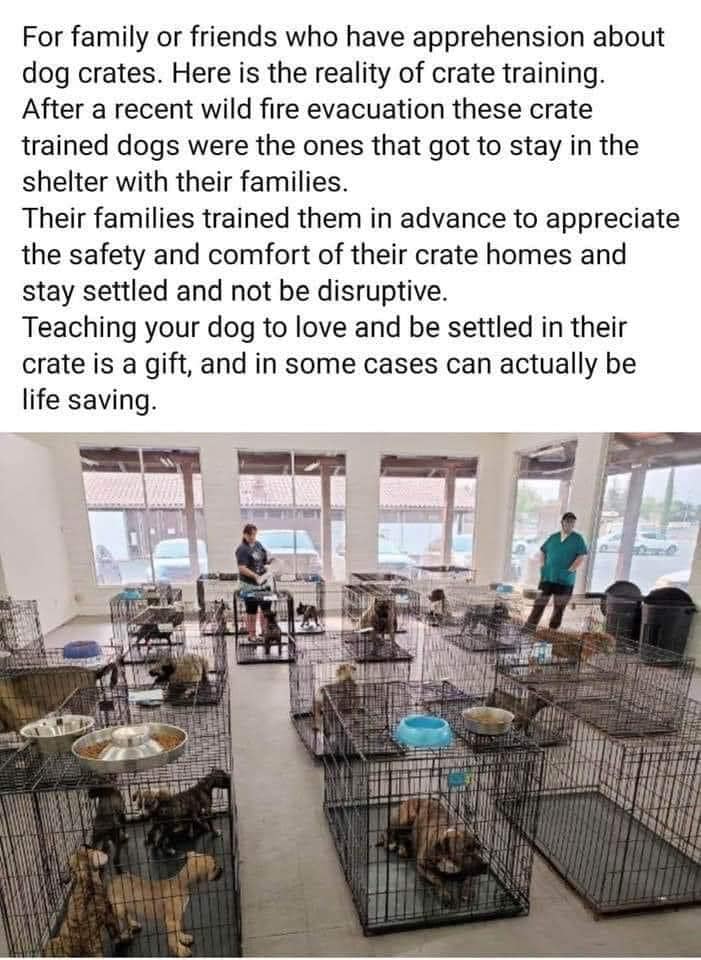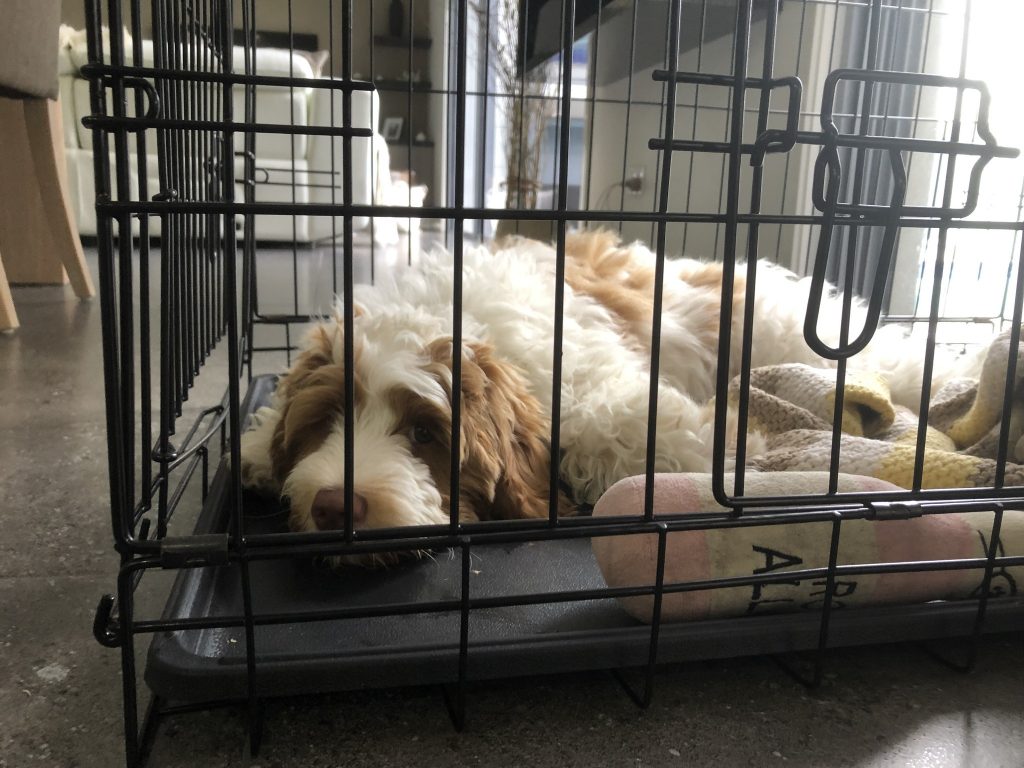PUPPY CRATE TRAINING
Do dogs like crates?
Many people feel that locking your dog up in a crate is cruel. Believe it or not, dogs instinctively seek out tight space. This small familiar area soothes them as well as diminishes the area they feel they need to protect. Many dogs make their own crates by crawling under coffee tables, desks and beds. It is not their cage, it is their den, and every dog needs a den. Training your dog to use a crate is not cruel and unusual punishment! Quite the contrary; when crate trained properly before long he or she will consider the crate as a "den" and go there automatically when they are tired or just want to be alone.
A crate provides your puppy a safe place and you peace of mind while you are not home. Until your puppy is fully housetrained, do not allow the pup free run of your house, or she will develop negative habits: she may toilet all over the house, and chew and destroy anything she can get her mouth or claws around: electrical wires, shoes, table/chair legs, carpets, you name i. And dogs will chew and swallow socks, underwear, toys, and these may cause bowel obstructions. These habits are very difficult to break, and may be very costly with property damage and vet bills, and even dangerous for the puppy. Keep puppies out of children's rooms, laundry and bathrooms.
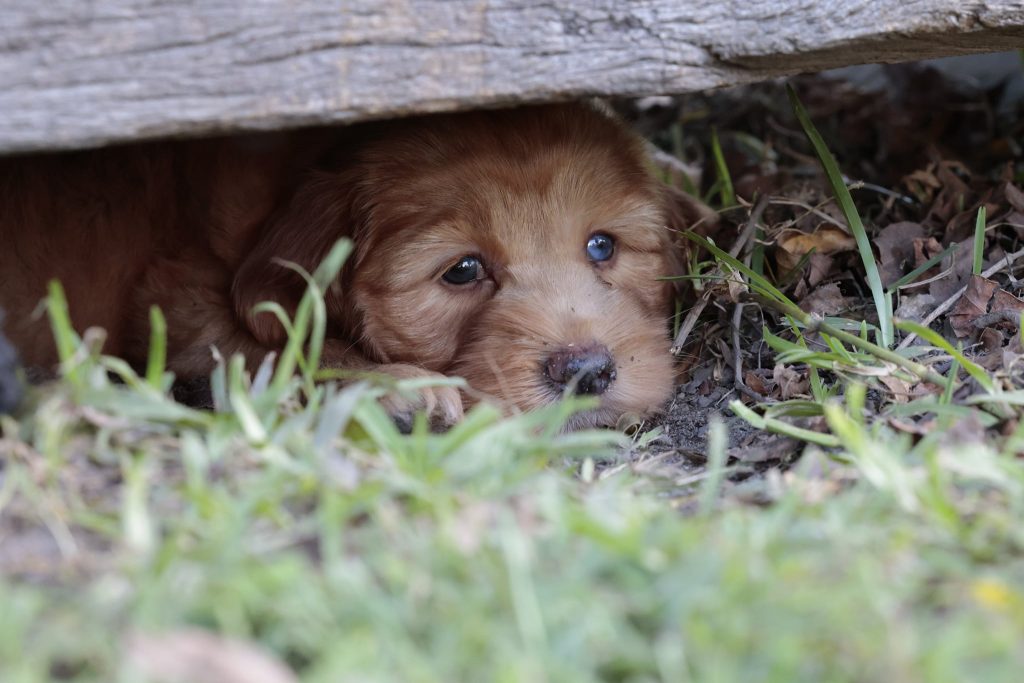
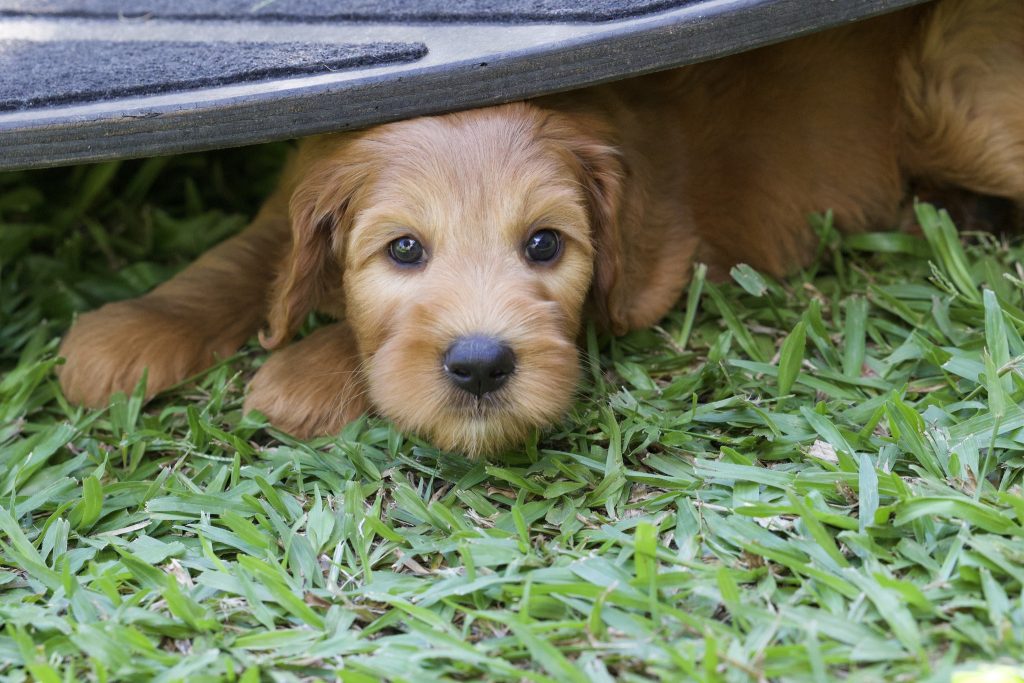
Why crate train?
Crate training is one of the most efficient and effective ways to train and housetrain your pup. Having a well behaved and well adjusted pet is all about providing experiences and opportunity where they can learn intuitively, and be trained without stress, and the more time you spend with your dog, the quicker and easier it will be to train them. And it is very important that you make provisions for your dog when you are not home. Crate training can help you to provide all of this.
Until your dog is housetrained, she should not be allowed free run of your house, even when you are home. Given free run, your puppy will develop habits of pooing and piddling everywhere, chewing furniture, shoes and carpeting, and destroying everything she can get her mouth or claws into. Pups chew and swallow anything that's smells or feels good, and toys, socks, can cause bowel obstructions and very large vet bills! Keep pup out of the children's room and bathroom and laundry. This is where the crate comes into its own!
The crate is a safe, familiar space for puppy when you are away from the home, when you are busy so you know where pup is, and we recommend for puppy to rest in when you are having dinner. (Speaking of dinner absolutely no jumping up on kitchen bench or table, this is not cute and will lead to ongoing bad habits.)
Why can’t I just confine my dog in my laundry, bathroom.....?
Leaving your pup/new dog in the yard, a bathroom or a laundry is counterproductive for many reasons. Unfamiliar and uncomfortable smells, large open spaces and slippery cold floors don't help the dog to feel relaxed and to cope with any separation stresses. They won't be relaxed but instead will create an association between those spaces and the fact that you are leaving them and this may lead to separation anxiety. The dog needs to feel safe and secure when you are away from home so that there is no anxiety associated with you being absent! They need a place to be that feels and smells safe, familiar and comfortable, and is somewhere that they willingly go, even when you are at home, as their 'den' or safe space where they feel soothed. Having your puppy/new dog in the crate when you they are home alone is your very best option. Think about the play pen if you are away for long periods of time. Also think about puppy daycare while pup is so small, especially during these months when socialisation is so important.
Tips for stress-free crate training
Following these guidelines and taking the time to properly crate train you puppy will allow him to associate his/her crate with being safe, secure and comfortable. This will give you peace of mind and make life easier, at home and away, long into your future together.
- Introduce the puppy to the crate GRADUALLY! If you have to, start training on a Friday night and finish by Monday morning before you leave for work.
- Give your puppy some edible treats in the crate to stimulate positive associations with the crate. If the puppy hesitates to go inside to eat, give a small treat in front of the crate at first, then just inside the doorway, and finally in the back of the crate. Also, occasionally through the day, drop small pieces of dog treats in the crate without your dog seeing: while your puppy investigates his new crate, he will discover edible treasures and this will create further positive associations with the crate.
- In the beginning, praise and pet your pup when he enters the crate voluntarily. Do not push, pull or force the puppy into the crate. Use as treat to lure him into the crate, give him another treat once he is in the crate. Do not close the door. Do this several times throughout the day. If you try to do it only when you’re going to lock the door, the puppy will get wise and not enter at all.
- Overnight is an exception - you may need to place your pup in his crate and shut the door upon retiring. (In the early days, the crate should be placed next to your bed overnight.) We recommend taking pup out to the toilet around 10pm before you go to bed. Take a torch so you can watch what he does. Spend time out there with puppy, often they will do a poo and this saves the crate.
- It is advisable first to crate your pup for short periods of time while you are home with him. In fact, crate training is best accomplished while you are in the room with your dog. Getting him used to your absence from the room in which he is crated is a good first step. This prevents an association being made with the crate and you’re leaving him/her alone.
- Never let pup out of the crate if pup is crying; wait for a break then let him out. If you let pup out of the crate when crying you are teaching him/her that is how I get out. Pup will then cry even louder & longer. After pup has had a sleep or rest in the crate (during the day) open the door & ask him out. At night time, pup doesn’t come out of the crate.
- In the early days, move the crate around the house so pup gets used to different places. Pup will want to be close to you most of the time.
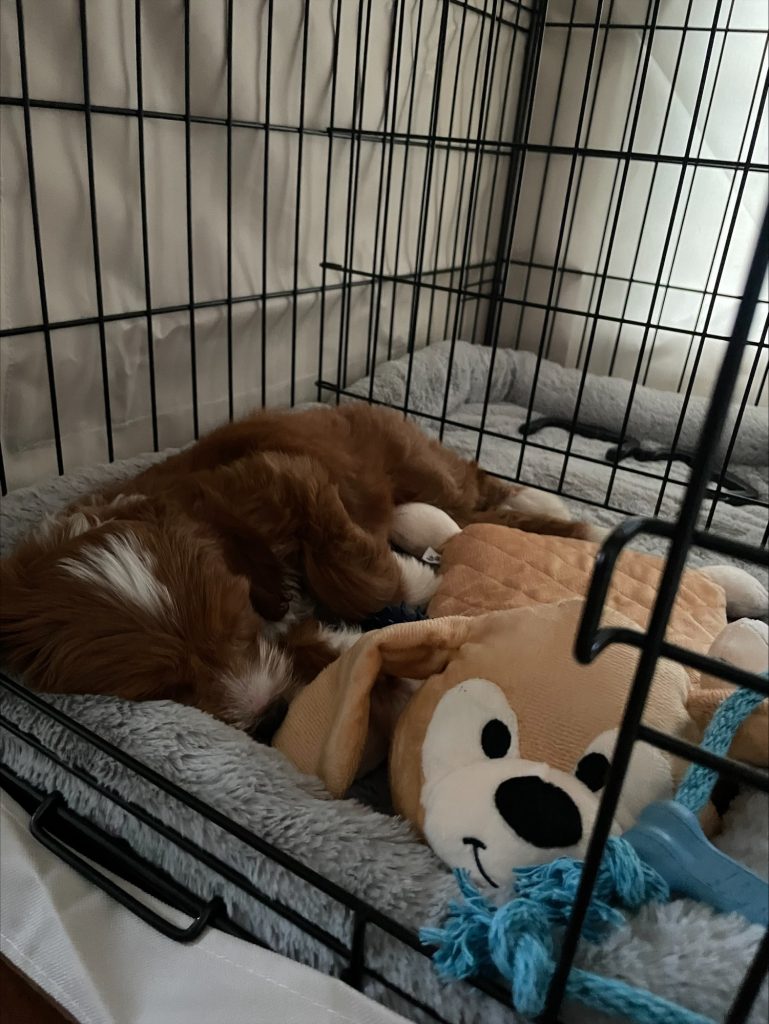
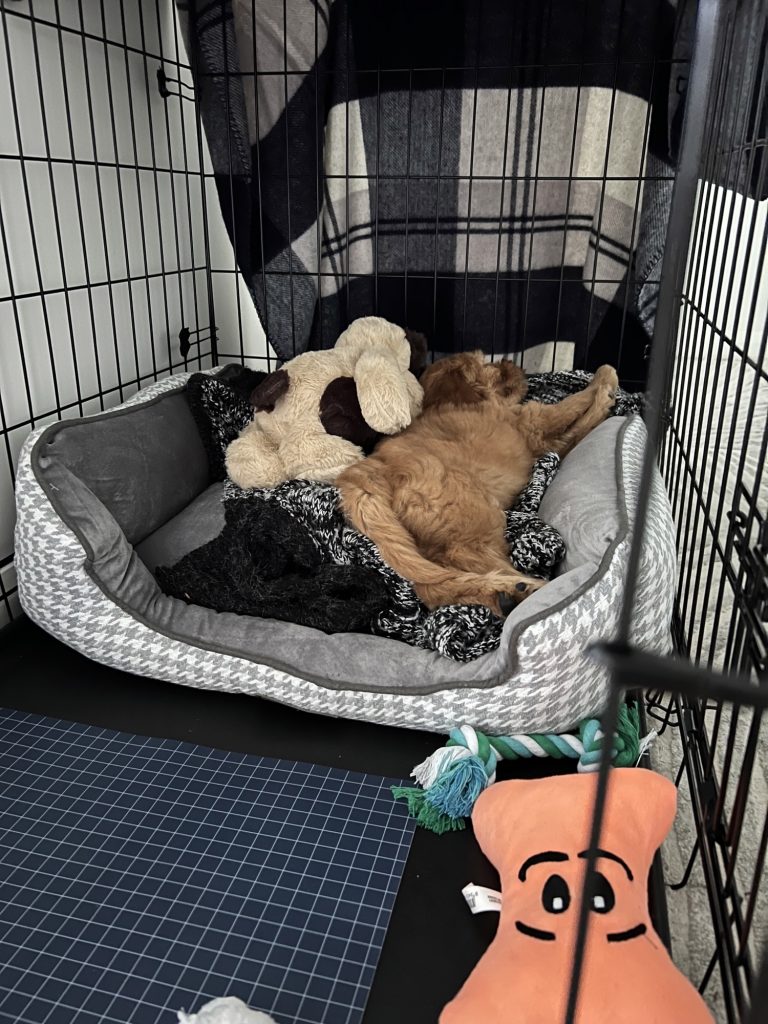
Setting up puppy's crate
Size of crate: The crate should only be big enough for the dog to stand up, turn around and lie down – any bigger and the dog may use it for a rest room. If you buy a large crate that will fit your puppy when it is full grown, then you should section off part of the crate so your puppy doesn't have too much room.
Toys and treats: Place your puppy's favourite toys and dog treats opposite the door opening, at the far end of the crate. Appropriate toys (like ‘Kong’) and balls must be inedible and large enough to not be swallowed. Any toys with smaller pieces should be removed to prevent choking and internal obstruction. You can also place a sterilised marrowbone in the crate with dog treats inside.
Water: A small dispenser-type water dispenser with ice water should be attached to the crate wall if your puppy will be confined in warm weather for more than two hours in the crate.
Bedding and toilet-training: Place a small woollen blanket or jumper inside the crate to make a comfortable, soft bed for your puppy; NEVER towelsl. If puppy wees, the woollen item will absorb moisture and puppy won't get cold; towels won't absorb the moisture. If your puppy wees on the bedding, remove bedding until the pup no longer wees in the crate.
Generally pup only takes a few nights or up to a week to stay dry overnight. If you are feeding meat in the afternoon before 5pm as we suggest, pup shouldn’t need more water before bed. Let pup out early in the morning & take him straight outside, go outside with him in the early days so he feels more relaxed.
If the puppy chews the bedding, remove it to prevent the pup from swallowing or choking on the pieces. Most puppies prefer lying on soft bedding, but a puppy that pushes the blanket to one end of the crate to avoid it may be telling you he prefers resting on a hard, flat surface.
Where to put the crate? While you are home, try to place the crate near or next to you whenever possible. The feeling of security that the puppy experiences being close to you will translate somewhat to simply being inside the crate, and the pup will be able to go inside it without feeling lonely or isolated when you go out. When you are not home, place the crate in whichever room your family spends most time in, usually the living room. If you are going to be away for some time there are small puppy play pens available which give a lot more room for puppy to move about and play. These can be folded up and put away when not in use.
Toileting in the crate - what's wrong?
It is rare for a pup or dog to toilet in their crate if it is properly sized and the dog is an appropriate age to be crated for the amount of time. If your pup/dog continues to eliminate in their crate, there may be a reason:
- The puppy is too young to have proper control yet.
- The puppy’s diet may be poor or rich, or the meals too large.
- The pup was not toileted prior to being crated.
- The pup has worms.
- The pup has a tummy upset - gaseous or loose stools.
- The pup drank a large volume of water before being crated.
- The pup was forced to eliminate in small confined areas prior to crate training (pet shop).
- The pup/dog is suffering from a condition such as prostate problem, bladder infection, etc.
- The puppy or dog may be experiencing stress and severe separation anxiety when left alone.
NOTE: Puppies purchased in pet stores, or puppies which were kept solely in small cages or other similar enclosures at a young age (between approximately 7 and 16 weeks of age), may be considerably harder to housebreak using the crate training method due to their having no choice but to eliminate in their sleeping area during this formative stage of development. This is the time when most puppies are learning to eliminate outside their sleeping area. Confining them with their waste products retards the housebreaking process, and this problem can continue throughout a dog's adult life.
Occasional accidents in the crate
If your puppy toilets in his crate while you are out, do not punish him upon your return. Wash out the crate using a pet odour neutralizer (such as Nature's Miracle). Do not use ammonia-based products, as their odour resembles urine and may draw your dog back to urinate in the same spot again.
The crate as punishment
NEVER use the crate as a form of punishment or reprimand for your puppy or dog. This simply causes the dog to fear and resent the crate. If correctly introduced to his crate, your puppy should be happy to go into his crate at any time. You may however use the crate as a brief time-out for your puppy as a way of discouraging nipping or excessive rowdiness.
NOTE: Sufficient daily exercise is important for healthy puppies and dogs. Regular daily walks should be offered as soon as a puppy is fully immunized. Backyard exercise is not enough!
Children and the crate
Do not allow children to handle your dog while he/she is in the crate. The crate is your dog's private sanctuary. His/her rights to privacy should always be respected.
Barking/crying in the crate
In most cases a pup that cries incessantly in his crate has either been crated too soon (without taking the proper steps as outlined above) or is suffering from separation anxiety and is anxious about being left alone. Some pups may simply need more exercise. Others may not have enough attention paid them. Some breeds of dog may be particularly vocal (e.g., Miniature Pinchers, Mini Schnauzers, and other frisky terrier types). You may need to increase the amount of exercise and play your dog receives daily.
How long can puppy be in crate while you're away?
A puppy left in a crate when you leave the home must be well trained to be calm and relaxed in the crate.
A puppy should never be confined to a crate when you are not home, for longer than their age-appropriate time.
(i.e. their age in months plus one. e.g. a 2 month old puppy maximum time is 3 hours (2 months+1), a 3 month old dog never more than 4 hours (3months+1), 5 month old pup not more than 6 hours.
After 6 months, NEVER more than 8 hours. And time in crate will also be determined by your dog's response to the time spent inside, it must be a positive place to be.
Make sure puppy/dog is exercised, toileted and stimulated before crating, and has something appropriate like chew toys to keep occupied while confined.
If the time is longer than a couple of hours, leave a self-dispensing water container.
Never crate and leave if temperature is uncomfortable.
Consider Puppy Daycare for puppies (once vacs completed) if you are going to be away from home for hours at a time; the socialisation will also be great for the pup.
When NOT to use a crate
Do NOT crate your puppy or dog if:
- your puppy is too young to have sufficient bladder or sphincter control.
- your puppy has diarrhoea. Diarrhoea can be caused by: worms, illness, intestinal upsets such as colitis, too much and/or the wrong kinds of food, quick changes in the dogs diet, or stress, fear or anxiety.
- your pup is vomiting.
- you must leave your pup crated for more than the Crating Duration Guidelines suggest.
- your puppy has not eliminated shortly before being placed inside the crate. (See Housetraining Guidelines for exceptions.)
- when temperatures reach uncomfortable levels
- your puppy has not had sufficient exercise, companionship and socialisation.
The cost of a crate
Crates can cost between $35 and $150 depending on the size and the type of crate and the source. If you think about the crate usage for the lifetime of your dog, the cost is very little but the crate is almost priceless!
Just one more thing...
Consider crate training as a huge bonus for if you need to relocate with your pet! Whether you are camping, moving home, staying in holiday accommodation, or for any and every reason, crate training makes life easier for you and your dog..
